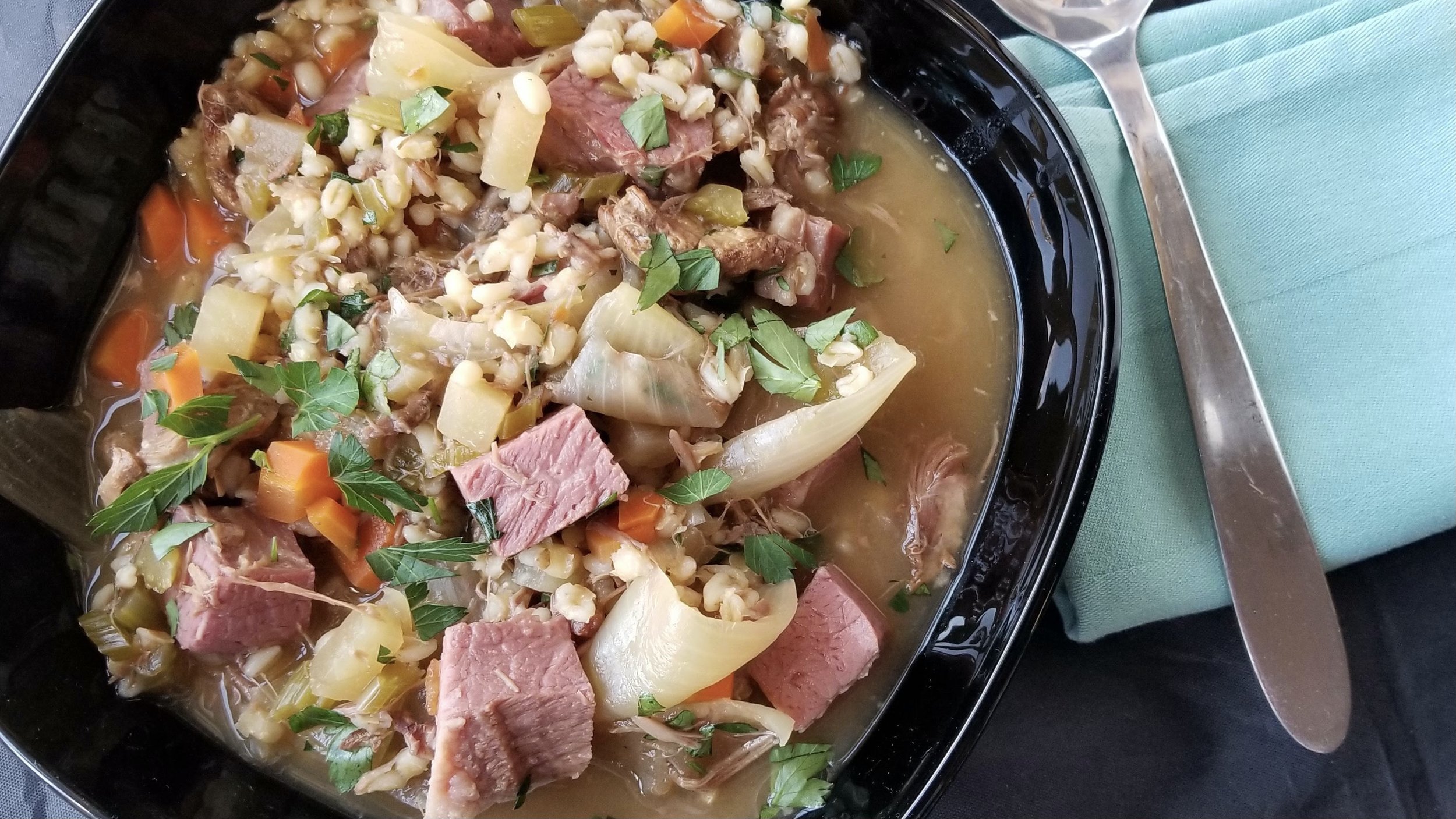SCOTCH IRISH BROTH
Scotch-Irish barley broth uses both lamb meat as well as corned beef.
We know the dish called “Scotch broth” to be a stew-like soup based in lamb, heavy on the barley and vegetables.
The earliest versions of Scotch broth, however, were beef-based soups. One of the first printed cookbooks of Scotland, “A New and Easy Method of Cookery,” by Elizabeth Cleland, published in 1755, has this recipe “To make Scots Barley Broth”:
“BOIL a Hough [shin or shank] of Beef in eight Pints of Water, and a Pound of Barley, on a slow Fire; let it boil to four Pints; then put in Onions, Pepper, Salt, and Raisins if you like them, or you may put in Greens and Leeks.”
When the precise pivot came in Scotch broth from beef to lamb is unclear. But recipes in Scottish cookbooks from the early 1800s construct stocks, broths and “hotch-potches” using only lamb (at that time called “mutton”). “The Cook and Housewife’s Manual” from 1829, written by a “Mistress Margaret Dods” makes a “Scotch hotch-potch” which, for all intents and purposes, is a lamb-based Scotch broth without the barley only.
Given the strong and lengthy Irish heritage in our country, the Irish-American tradition is to boil a slab of corned beef with vegetables, served alongside potatoes.
Why not boil together both beef and lamb for a stab at a “Scotch-Irish Barley Broth”? And a tip of the hat, in consideration, toward the millions of North Americans of Scotch-Irish (sometimes spelled “Scots-Irish”) lineage. These originally are those who immigrated to the United States in the 18th and 19th centuries, settling in Western Pennsylvania and throughout Appalachia, and whose ancestors were the Ulster Protestants out of Northern Ireland, themselves from the Scottish Lowlands and Northern England.
The Scotch-Irish have given much to American cooking. We owe to them more homage for corned beef and cabbage (and soda bread and colcannon) than to the Catholic Irish who immigrated here during those same centuries but who settled mostly in the northeast of our country.
Note that the method of “corning” (salting) beef goes back centuries in what is now the United Kingdom and throughout Europe. The “corn,” in English, refers to the size of the salt used, “corn” being a synonym in the U.K. for “grain,” hence salt pieces the sizes of raw oat or wheat grains.
We Americans (Scotch-Irish, Irish or pretenders to both) eat far more corned beef than the Irish do. Corned beef proliferated on this side of the Atlantic because it was the safest way, from the 1600s into the early 1800s in the days before refrigeration, to transport beef from the Old World to the New World.
The recipe here comes from several sources, including Elizabeth Cleland’s, but is adapted from mostly the two noted. If you’re interested, browning the lamb in a bit of oil adds more aroma and flavor. That is a French technique, hence not common in Irish, traditional English or Scotch cookery, but I find it a fine complement.
RECIPE: Scotch-Irish Barley Broth with Lamb and Corned Beef
Adapted from “The Joy of Cooking,” Irma Rombauer (The Blakiston Company, 1931) and “The Fanny Farmer Cookbook,” Marion Cunningham (13th edition, Knopf, 1979); makes 12 cups and freezes well.
Ingredients
3/4 cup pearl barley
12 cups water, divided
2 pounds lamb shanks (or 3 pounds lamb neck pieces or 2 pounds lamb shoulder chops)
2 pounds lean corned beef brisket
1 medium onion, peeled and halved through its “poles”
2 tablespoons unsalted butter
2 cups finely diced mixed vegetables (any combination of carrot, celery, turnip, parsnip or leek)
Salt and freshly ground black pepper
Flat-leaf parsley for garnish, roughly chopped
Directions
Soak the barley for at least 6 hours (or overnight) in 2 cups of the water. When ready to cook, drain the barley discarding the soaking liquid. Trim the meats of any obvious fat.
If you seek deeper, richer flavors to the broth, brown the lamb well in some olive or other vegetable oil before proceeding.
In a large pot or Dutch oven, cover the meats with 10 cups water. Add the onion halves and the drained barley. Bring to a boil, then lower to a simmer and cook for 2 hours, with the pot’s cover ajar.
One-half hour before the cooking of the meat is done, melt the butter in a skillet and brown the diced vegetables for 10 minutes, stirring. Scrape everything from the skillet into the simmering meat and barley and cook for another 20 minutes, stirring lightly a couple of times.
Skim the pot of any visible fat (or cook the day ahead, chill overnight and remove the risen, congealed fat). Remove the meat from any lamb bones and dice or shred it, returning it to the pot, discarding the bones and cartilage. Cut the corned beef into large pieces, first against the grain and then with it, and return it to the pot. Remove the onion halves from the broth and cut into large pieces, discarding the root ends, returning the onion to the pot.
Keep the broth very warm or hot and adjust the seasonings with salt and pepper (depending on how salty the cure was for the corned beef, little or no salt may be in order). Serve in large, warmed bowls, dividing the solids, and garnish with the parsley.

